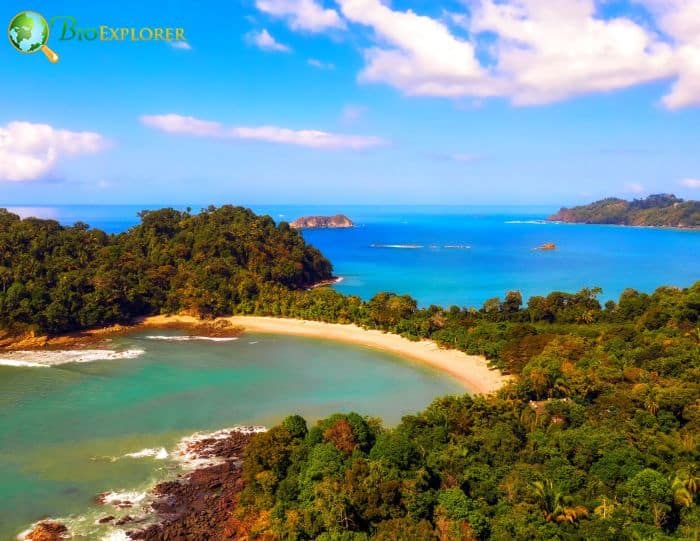
Costa Rica Monkeys: Costa Rica, a small country in Central America, is a treasure trove of biodiversity. It is home to an incredible 4% of the world’s total species[1], making it a hotspot for wildlife enthusiasts.
Monkeys hold a special place among the diverse creatures that inhabit this tropical paradise. They are an integral part of the Costa Rican ecosystem, contributing significantly to the health and vitality of the rainforests.
Table of Contents
Types of Monkeys in Costa Rica
Costa Rica, the Spanish-speaking nation, is home to 4 species of monkeys. Each species is unique, with its behaviors, habitats, and characteristics. Let’s delve into the fascinating world of these New World Monkeys.
1. Central American Squirrel Monkey

The Central American squirrel monkey, also known as the red-backed squirrel monkey, is one of the smallest primates in Costa Rica. Despite their small size, these monkeys play a crucial role in seed dispersal, contributing to the growth and diversity of the rainforest. They are primarily found in the Pacific lowland forests of Costa Rica. Unfortunately, their population is declining due to habitat loss and fragmentation.
What Animals Live In Rainforests?
![]()
2. Panamanian White-faced Capuchin

The Panamanian White-faced Capuchin is one of the most recognized monkeys in Costa Rica, known for their distinctive white face contrasted with their black body. They are highly intelligent and exhibit complex social behaviors. Capuchins are omnivores, feeding on a diet of fruits, insects, and even small mammals. They inhabit various forest habitats in Costa Rica, from dry forests to rainforests.
![]()
3. Mantled Howler Monkey

The Mantled howler monkey is the most widespread primate species in Costa Rica. Named for their loud, guttural howls, these primates are an iconic part of the Costa Rican soundscape. They spend most of their time in the tree canopy, feeding on leaves, fruits, and wildflowers. Howler monkeys play a vital role in the ecosystem by dispersing seeds and promoting new growth in the forest.
![]()
4. Geoffroy’s Spider Monkey

Geoffroy’s Spider Monkey, also known as the black-handed spider monkey, is known for its long, slender limbs and prehensile tail. They are highly social animals living in large groups and communicating through complex vocalizations, body postures, and facial expressions. Spider monkeys are primarily frugivores and play a significant role in seed dispersal. However, they are currently listed as endangered by the IUCN due to habitat loss and hunting.
![]()
Habitats of Monkeys in Costa Rica

Costa Rica’s diverse landscapes provide a variety of habitats for its monkey populations. These habitats range from lush rainforests to protected national parks, reserves, and coastal regions.
- Rainforests: Costa Rica’s rainforests are teeming with life, providing a rich habitat for all four species of monkeys. In addition, these dense forests offer plenty of food and shelter, making them ideal for arboreal creatures like monkeys.
- National Parks and Reserves: Costa Rica’s commitment to conservation is evident in its extensive national parks and reserves network. These protected areas serve as crucial habitats for monkeys, offering them a haven from human encroachment. Parks like the Manuel Antonio National Park[2] and Corcovado National Park[3] are renowned for their monkey populations.
- Coastal Regions: The coastal regions of Costa Rica, particularly along the Pacific coast, are also home to various monkey species. In addition, these areas offer a unique ecosystem where the forest meets the sea, providing the monkeys with diverse food sources.
Threats to Monkeys in Costa Rica

Despite their adaptability, monkeys in Costa Rica face several threats. The primary threats include deforestation, climate change, and human interaction.
- Deforestation: Deforestation is the most significant threat[4] to Costa Rica’s monkeys. Monkeys lose their homes and food sources as forests are cleared for agriculture and development.
- Climate Change: Climate change poses a long-term threat to monkeys in Costa Rica[5]. Changes in temperature and precipitation patterns can disrupt the delicate balance of the ecosystems that these monkeys rely on.
- Human Interaction: Human interaction, whether through habitat encroachment, hunting, or the pet trade, poses a significant threat to monkeys. Monkeys are often captured for the pet trade[6], while others are killed for their meat or because they are considered pests.
![]()
Conservation Efforts

Various conservation efforts are underway in Costa Rica[7] in response to these threats. The government and non-profit organizations lead these efforts and focus on protecting monkey habitats and promoting sustainable tourism.
- Role of Government and Non-Profit Organizations: In collaboration with non-profit organizations, the Costa Rican government has established numerous protected areas to conserve monkey habitats. These organizations also conduct research and education programs to raise awareness about the importance of monkey conservation.
- Importance of Sustainable Tourism: Sustainable tourism is crucial in conservation efforts. By promoting responsible travel practices, tourism can contribute to conservation while providing economic benefits for local communities.
![]()
Tips for Monkey Spotting in Costa Rica

![]() If you’re hoping to spot monkeys during your visit to Costa Rica, the best time is early morning or late afternoon when they are most active. Some of the best locations for monkey spotting include Manuel Antonio National Park, Corcovado National Park, and the Osa Peninsula[8].
If you’re hoping to spot monkeys during your visit to Costa Rica, the best time is early morning or late afternoon when they are most active. Some of the best locations for monkey spotting include Manuel Antonio National Park, Corcovado National Park, and the Osa Peninsula[8].
![]()
Monkeys are integral to Costa Rica’s rich biodiversity. Their survival is intertwined with the health of the ecosystems they inhabit. As we continue to learn about these fascinating creatures, we must take action to protect them and their habitats. Let’s all contribute to the conservation efforts and ensure that future generations can also marvel at the wonder of Costa Rica’s monkeys.
![]()











